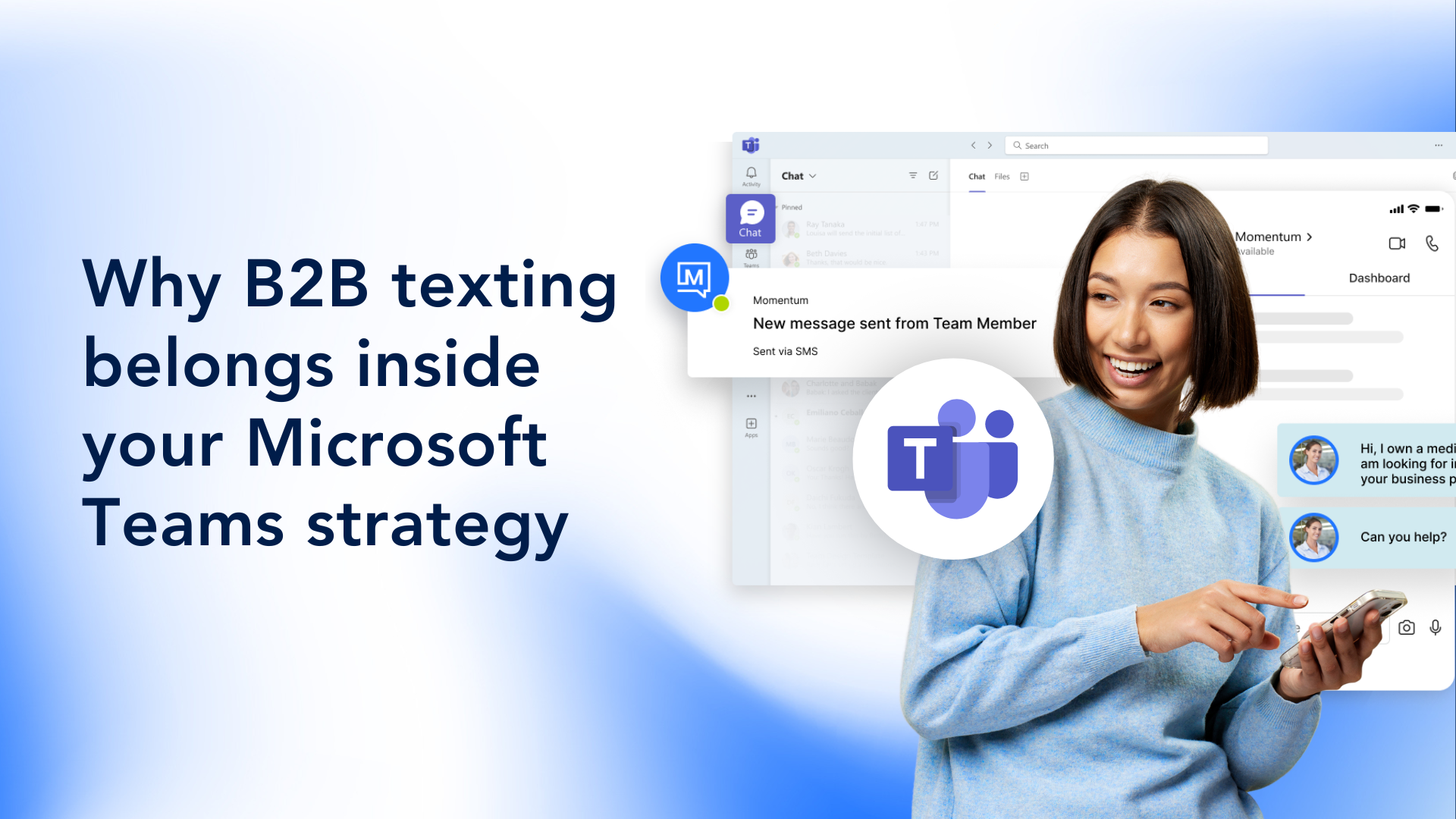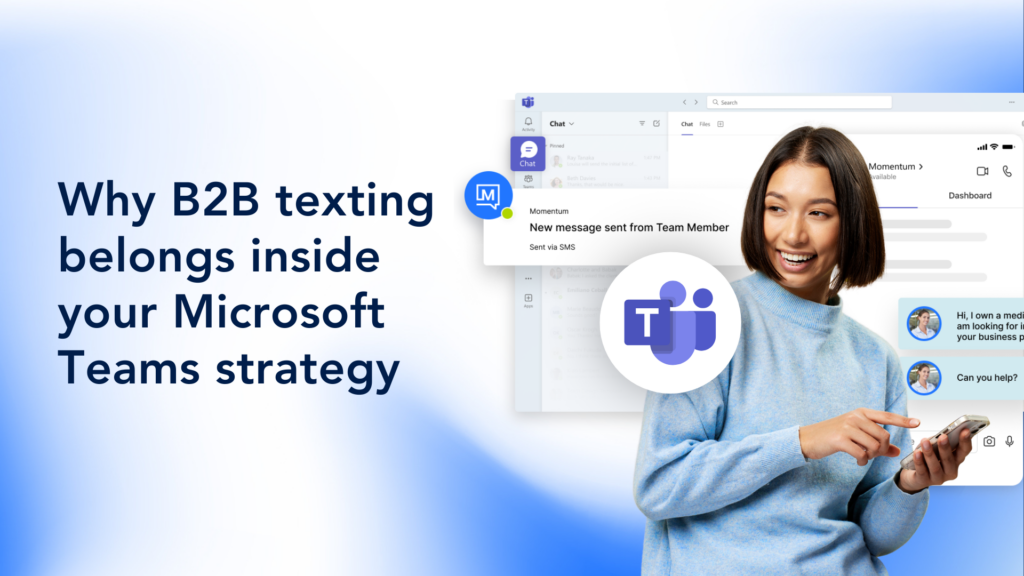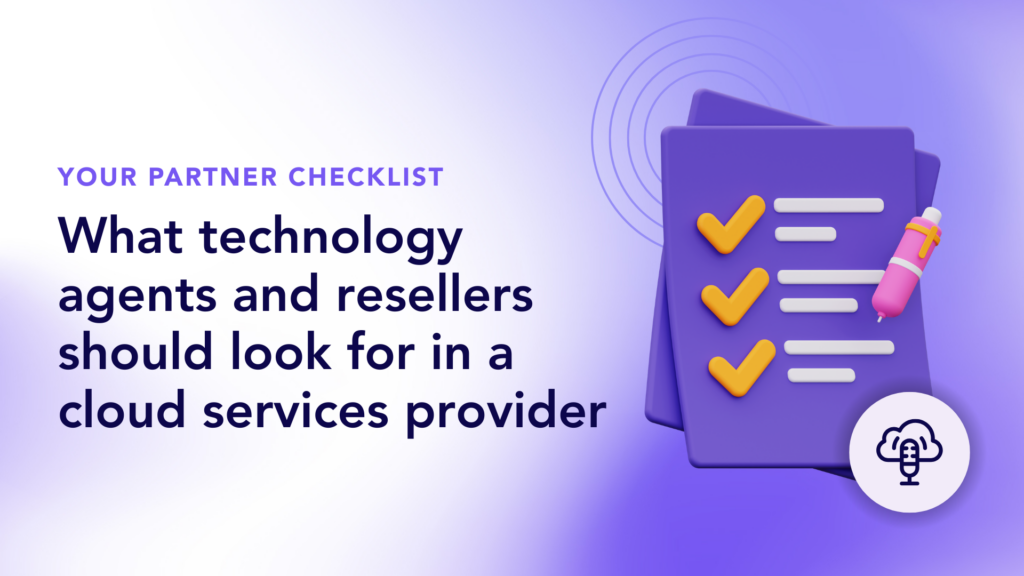Most teams still juggle too many tools to get a single message out. They have one platform for email, another for chat, and a third for video. And when it comes to texting customers? They’re stuck switching apps, copying numbers, or relying on disconnected third-party tools.This leads to delays, missed conversations, and zero context when it matters most.
Microsoft Teams solves the problem by bringing voice, video, chat, and texting into one platform. With fewer silos and faster workflows, teams can communicate in real time without switching apps.
Before diving into how it works, let’s look at why business texting still punches way above its weight, and why it belongs inside your most-used workplace tool.
Why you need B2B texting in your toolbox
Without SMS, teams often rely on slower channels like email or calls that get missed, ignored, or delayed. The longer it takes to connect, the more momentum gets lost, especially in high-touch industries like sales, field services, and logistics.
The good news is that text messaging outperforms other business communication channels. It’s fast, reliable, and consistently gets seen.
What makes B2B texting so effective? Here’s what the numbers say:
| SMS messages have a 98% open rate compared to email’s 26.8%, with 90% of people responding within 30 minutes. This makes them incredibly useful for sending critical updates and time-sensitive promotions. | Over 80% of businesses say AI has improved their SMS marketing campaigns, saving 4-6 hours weekly through automation and smarter targeting. As Microsoft expands AI integration across Teams, expect that same intelligence to extend to texting. |
|---|---|
| Companies that use SMS marketing as part of their broader omnichannel marketing strategy see a 47% increase in customer engagement. | Text messaging remains the preferred marketing channel for 75% of consumers because of how personal and immediate texting feels. |
What’s clear: texting isn’t just for marketing teams.
- Support teams use it to confirm appointments or resolve issues faster.
- Operations teams use it to keep remote workers informed.
- Sales teams use it to follow up and get replies in minutes, not days.
SMS still delivers when speed matters most. Bringing it inside Microsoft Teams adds even more value by making texting part of your omnichannel workflow, with voice, video, chat, and messaging all connected in one secure platform.
That’s exactly why Microsoft Teams has expanded to support SMS. Your team can manage customer conversations, internal coordination, and urgent updates through a single, familiar interface without missing a beat.
How businesses use SMS in Teams (B2B texting use cases)
Texting solves a simple but persistent problem: people want asynchronous communications, not real-time. They’d prefer to read a message on their terms, rather than feeling obligated to instantly respond.
Texting, messaging, and chatting all support this. And when it’s integrated into Microsoft Teams, it becomes a faster, more reliable way to reach people without switching platforms. It keeps conversations moving, workflows clean, and responses timely.
Here’s how businesses are putting it to work.

Customer service: Faster support without the wait
Most customers don’t want to wait on hold or dig through a support portal to get help. SMS gives support agents a simple way to follow up, confirm resolutions, or send quick updates directly from Teams without requiring the customer to download anything or open another app.
Compared to email, SMS feels more immediate and more personal. It also gets seen faster, which is helpful when troubleshooting time-sensitive issues. For customers, it means faster answers. For agents, it means fewer tickets piling up. For the business, it’s a win-win.
Sales follow-ups: Close the gap between touchpoints
Sales teams know speed-to-lead is everything. But email gets ignored, and cold calls often go unanswered.SMS gives reps a direct way to check in after a meeting, confirm next steps, or send a quick reminder from Teams.
This helps maintain momentum in the sales cycle and boosts response rates. It’s more effective than waiting for an email reply and less intrusive than another call. And because it’s integrated into Teams, reps have full context from the CRM, previous calls, and internal chats all in one place.
Field service and logistics: Real-time updates that get through
Field teams need quick, reliable updates. Missed connections or delays cost time and money. With SMS inside Teams, dispatchers can send real-time instructions, location changes, or urgent alerts to workers on the move without requiring them to check email or log into another system.
Compared to push notifications or app-based messages, SMS cuts through immediately. It’s also device-agnostic, making it useful when teams use mixed hardware or operate in areas with spotty data coverage.
Appointment and service reminders: Reduce no-shows
Missed appointments hurt revenue and productivity. SMS reminders sent from Teams give businesses a simple way to confirm upcoming meetings, service windows, or check-ins with clients or internal stakeholders.
Texting outperforms email reminders for simple reasons. People see them faster, they don’t get caught in spam filters, and they often trigger immediate responses. Reducing no-shows with a few automated texts can deliver a measurable ROI almost immediately.
Internal notifications: Keep teams in the loop, no matter where they are
Sometimes chat or email just isn’t fast enough. For teams that are split across time zones, working in the field, or not checking their inbox regularly, SMS offers a more immediate way to push updates.
Texting from Teams ensures those messages still come from a secure, managed environment. Whether it’s a shift change, system update, or alert about a power outage, SMS ensures it reaches the right people, quickly and reliably.
Emergency communication: Reach everyone when it matters most
In a crisis, clarity and speed matter. SMS allows companies to bypass slower channels and deliver urgent information straight to employee phones, even if those employees aren’t in front of a screen.
Fire drills, safety alerts, system-wide outages, or weather-related office closures are common use cases where Teams SMS can centralize and deliver the message quickly. It’s a practical step toward stronger business continuity planning.
Billing and collections: Send quick nudges without escalation
Not every past-due account needs a phone call. A friendly payment reminder by text is often all it takes to prompt action, and it’s far less confrontational than a collection call or formal notice. When billing teams can send those nudges from inside Microsoft Teams, they cut down on tool switching and manual tracking. SMS offers a human way to stay professional and efficient, without disrupting the rest of the workflow.
Channel partner communication: Strengthen alignment without delay
Channel partners need quick access to updates on inventory, pricing, promotions, or service issues. Email is too slow for time-sensitive updates, and not all partners are active in Teams or Slack environments.
SMS offers a direct, reliable way to communicate with external partners while ensuring communications stay centralized inside Microsoft Teams. This helps avoid missed sales opportunities, miscommunications, or delays in co-branded campaigns.
Procurement and vendor coordination: Keep supply chains moving
Procurement teams often rely on dozens of external vendors. When there’s a delay, price shift, or urgent PO change, getting a fast answer matters. Texting through Teams helps cut down the back-and-forth when vendors don’t respond to email or log into procurement portals.
SMS also works well when dealing with small vendors who may not be on Teams or who work in the field.
Regulatory or compliance notifications: Proactive communication for high-stakes environments
For organizations in healthcare, finance, or critical infrastructure, compliance deadlines and regulatory updates can’t wait for email open rates.
SMS can be used to notify internal teams or external stakeholders about policy changes, upcoming audits, or actions required to stay in compliance. Centralizing these messages in Teams ensures audit trails stay intact and access stays controlled.
What Microsoft Teams Calling Plan SMS can (and can’t) do right now
Now that the value of business texting is clear, here’s what Microsoft Teams currently supports for SMS, and where it is still growing.
What it can do
- Available to users with a Microsoft Calling Plan in the US and Canada (more countries coming soon)
- Supports one-to-one texting from within the Teams app
- Messages are tied to the user’s Teams phone number
- Works on both desktop and mobile Teams clients
- Admins can enable and manage SMS through the Teams Admin Center
What it can’t do (yet)
- No support for group messaging or MMS
- Not available for Operator Connect or Direct Routing users
- Requires compliance with 10DLC regulations and registration through
- The Campaign Registry (TCR). Additionally, you should expect a longer provisioning timeline (6 to 8 weeks) due to strong demand for Calling Plan SMS.
- Calling plan SMS limits are fairly low right now, ranging from 100-200 per month.
Microsoft isn’t stopping with the basics. Here’s a look at how Teams SMS is evolving to cover even more business needs.
Where Microsoft is headed with Teams SMS
Microsoft has made it clear that SMS inside Teams is just getting started. The current feature set covers basic one-to-one messaging, but there’s more on the way.
Here’s what’s on the roadmap, based on what’s publicly available:
- Regional expansion: SMS capabilities launched for Calling Plan users in the US and Canada. Microsoft plans to extend support to more markets over time.
- Improved messaging features: Future updates may include group texting, MMS support, and richer message handling. These will make SMS more versatile for customer service, sales, and field operations.
- Deeper integration across Microsoft 365: As Microsoft continues embedding AI and analytics across Teams, expect SMS to benefit from tools like message tracking, engagement insights, and policy management.
- Compliance and control: Admins will see better controls for SMS-specific policies, retention, and auditing, which is key for regulated industries.
Why this matters: Microsoft is investing in SMS as a native channel inside Teams. As the capabilities grow, so does the value of managing voice, video, chat, and texting in one secure platform.
If your business is already using Teams, getting started with SMS now means you’re well-positioned to take advantage of everything that’s coming next.
Why Teams is the ideal home for B2B SMS
Texting becomes even more powerful when it lives inside the tool your team already uses for communication.
Microsoft Teams brings voice, video, chat, and now, SMS into a single, familiar workspace. There are no extra apps, no context switching, and no gaps in communication.
Here’s what that means for businesses:
| Centralized communications Conversations stay in one place. Whether a chat starts in Teams, shifts to a call, or continues over text, your team can manage it all in one thread. That reduces context switching, speeds up collaboration, and makes follow-ups easier to track. | Improved customer and partner experience Messages get through faster, and replies come quicker. Whether you’re coordinating with customers or external partners, SMS inside Teams makes it easier to stay responsive without confusion, delays, or needing to explain which channel to use. | Familiar interface, minimal training SMS works just like any other Teams conversation. No extra apps to install, and no new interfaces to learn. Teams users can text from the platform they already know, so adoption is smooth and training needs are minimal. |
|---|---|---|
| Simplified tech stack Using Teams for SMS eliminates the need for separate texting tools. That means fewer vendors to manage, lower software costs, and less complexity for IT. If your business already runs on Teams, adding SMS is a simple extension. | Faster workflows Sales, support, and field teams can follow up, respond, and coordinate from the same dashboard. There’s no need to copy numbers between tools or wait for email replies. That keeps tasks moving and helps close loops faster. | Better visibility and control SMS inside Teams gives IT full oversight of business messaging. Messages can be monitored, retained, and governed using existing compliance policies. That helps maintain security, support audits, and keep conversations aligned with internal standards. |
Centralized communications
Conversations stay in one place. Whether a chat starts in Teams, shifts to a call, or continues over text, your team can manage it all in one thread. That reduces context switching, speeds up collaboration, and makes follow-ups easier to track.
Improved customer and partner experience
Messages get through faster, and replies come quicker. Whether you’re coordinating with customers or external partners, SMS inside Teams makes it easier to stay responsive without confusion, delays, or needing to explain which channel to use.
Familiar interface, minimal training
SMS works just like any other Teams conversation. No extra apps to install, and no new interfaces to learn. Teams users can text from the platform they already know, so adoption is smooth and training needs are minimal.
Simplified tech stack
Using Teams for SMS eliminates the need for separate texting tools. That means fewer vendors to manage, lower software costs, and less complexity for IT. If your business already runs on Teams, adding SMS is a simple extension.
Faster workflows
Sales, support, and field teams can follow up, respond, and coordinate from the same dashboard. There’s no need to copy numbers between tools or wait for email replies. That keeps tasks moving and helps close loops faster.
Better visibility and control
SMS inside Teams gives IT full oversight of business messaging. Messages can be monitored, retained, and governed using existing compliance policies. That helps maintain security, support audits, and keep conversations aligned with internal standards.
How to enable SMS in Microsoft Teams
Getting started with SMS in Teams is straightforward, but there are a few important steps you’ll need to follow.
- Confirm Licensing: Make sure each user who needs SMS has a Microsoft Teams Calling Plan license. SMS is only supported with Calling Plans, not Operator Connect or Direct Routing.
- Assign Phone Numbers: Assign a Microsoft-provisioned phone number to each user who will send and receive SMS messages. Numbers must come through the Calling Plan service.
- Activate SMS in Teams Admin Center: Enable SMS at the organizational level and assign permissions to users through the Teams Admin Center. Without admin activation, users will not have texting capabilities.
- Register Your Brand and Campaigns: Complete The Campaign Registry (TCR) process to comply with 10DLC regulations. Registration protects your business from carrier filtering and ensures messages are delivered reliably.
- Verify Regional Support: Currently, SMS inside Teams is available only for Calling Plan users in the United States and Canada. Confirm your service area before rollout.
Once SMS is set up, the next step is making sure it fits your business needs and communication goals.
Is Microsoft Teams SMS right for you?
Not every business needs SMS inside Teams right away. It depends on how your teams communicate and what you expect from your tools.
Here’s when Microsoft Teams SMS makes sense:
- Your teams already live inside Teams for chat, meetings, and calls, and you want to add external messaging without adding new apps.
- You need a fast, reliable way to reach customers, partners, vendors, or field employees who may not always be reachable by email.
- You want to simplify your tech stack by consolidating communications under one platform.
- You are looking for an easy way to meet business texting needs without deploying separate third-party SMS services.
Here’s when it may not be the best fit yet:
- You rely heavily on group texting or need to send multimedia messages (MMS). Teams SMS currently supports one-on-one texting only.
- Your organization uses Direct Routing or Operator Connect for voice services instead of Microsoft Calling Plans.
- You need global SMS coverage outside the US and Canada.
For many companies, starting now with Teams SMS provides immediate gains in speed and responsiveness, while laying a foundation for future expansion as Microsoft grows its capabilities.
Add Microsoft Teams B2B Texting to your communication stack
Texting has become an essential part of modern business communication. Customers, partners, and employees expect fast, direct conversations that move business forward. SMS closes gaps that email and voice often leave open, keeping your organization responsive and connected.
Microsoft Teams makes it easy to bring texting into the platform your teams already trust for collaboration, meetings, and calls. With one secure interface for all communication channels, your teams can move faster, deliver better service, and keep conversations visible and manageable across the organization.
Whether you need help deploying Teams, adding SMS capabilities, or customizing your environment for communication, collaboration, and AI-driven productivity, Momentum helps you unlock the full potential of Microsoft Teams.
And now with Momentum SMS, there’s no easier way to add texting to Teams. Our dedicated SMS solution eliminates many of the limitations of Calling Plan SMS, including:
- No 10DLC
- Send 250+ messages a month
- Includes MMS, group chats, and team-based messages
- Supports contact lists
- Enables SMS compliance with global relay, Smarsh, and Microsoft



